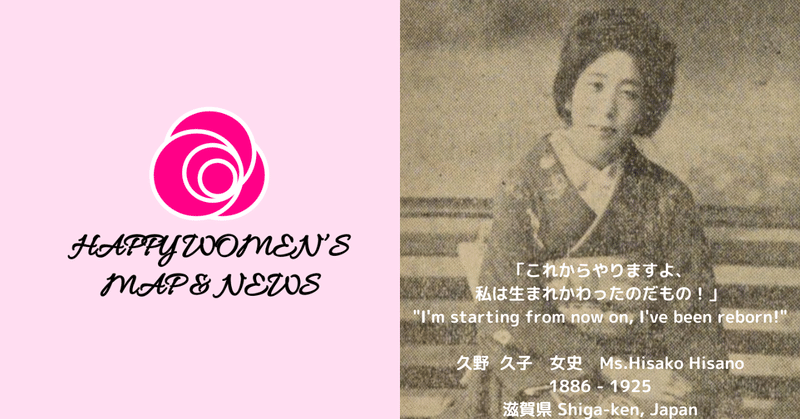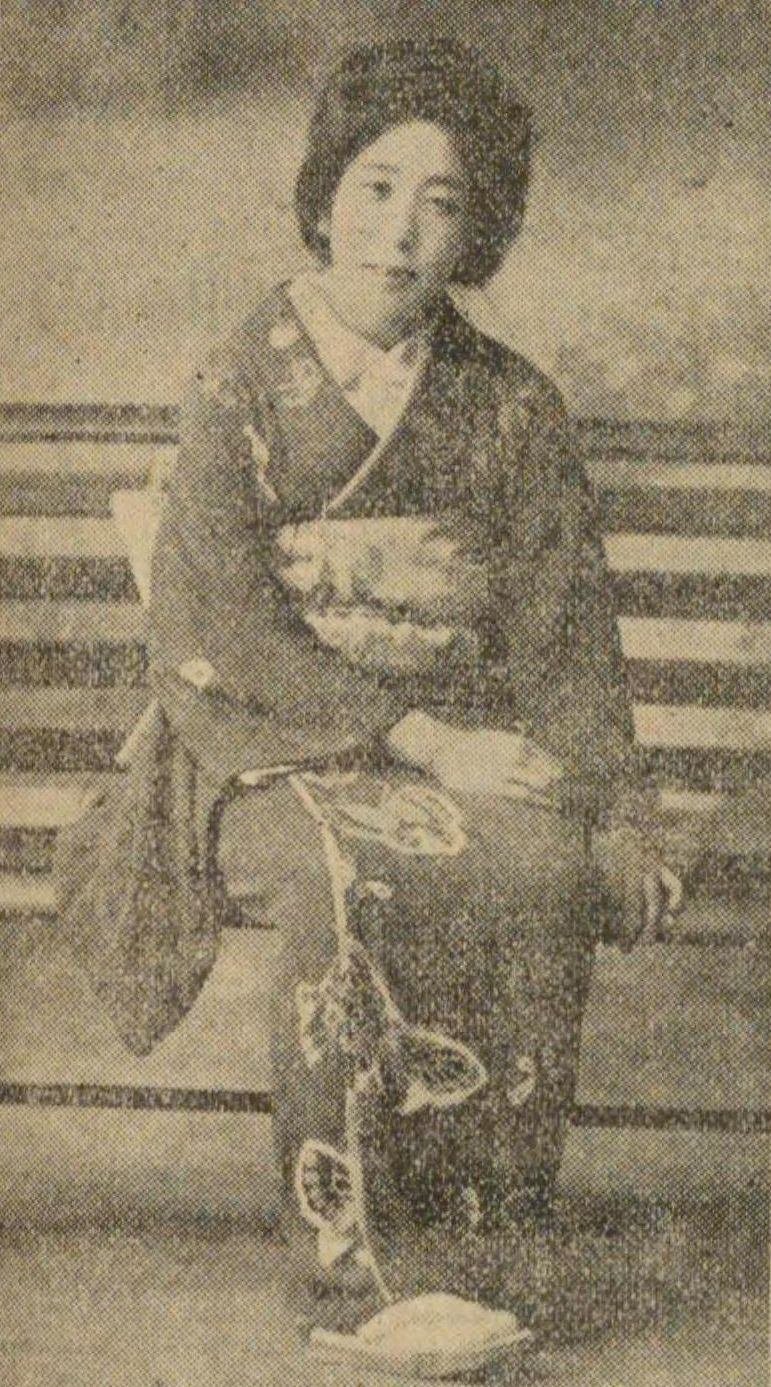
Happy Women's Map 滋賀県 日本初のピアニスト 久野 久 女史

「これからやりますよ、わたしは生まれかわったのだもの!」
"I'm starting from now on, I've been reborn!"
久野 久 女史
Ms. Hisa Kuno
1886 - 1925
滋賀県大津市馬場 生誕
Born in Otsu-city, Shiga-ken
久野 久女史は日本のみならず朝鮮・中国・オーストリアのウィーンで演奏を果たした日本初のピアニスト。べートーヴェンを得意として、鍵盤は血に染まり髪を振り乱し簪は飛んで着物は着崩れて汗が迸る情熱的な演奏は大きな感動を呼びました。
Ms. Hisa Kuno is the first Japanese pianist who has performed not only in Japan but also in Korea, China, and Vienna in Austria. She specializes in Beethoven, and especially impressed Japan with her passionate performance, in which her keyboard was stained with blood, her hair was disheveled, her hairpin flew off, and her kimono was torn and dripping with sweat.
*******
「日本初のピアニスト」
久子は質屋を営む裕福かつ大地主の家の娘として生まれ何不自由なく暮らすも、3歳の頃に自宅近所の神社の階段で転倒し、片足に障害を負います。芸事の好きな母の勧めで京都に出て琴と三味線とを習ひ、琴は生田流で三百曲以上を修め奥許を取得。やがて、東京の大学に通う兄・弥太郎の勧めで15歳で東京音楽学校(現:東京芸術大学)へ入学、日本クラシック音楽の草分け幸田延女子に師事してピアノを学びます。当初は成績不振で退学を勧告されるも久子は土下座して残留を頼み、猛練習の末に首席で卒業、卒業式で演奏します。「鍵盤を叩きつける指先から鮮血が散り」「髪を振り乱して簪が飛ぶ」「着物の裾がはだけて太ももがあらわになる」など情熱的で官能的な久子の演奏は、日本初のピアニストとして絶大な人気を誇るようになります。24歳で東京音楽学校の助教授に就任。日本女子大学でも教鞭をとりはじめます。国内はじめ満州、朝鮮で演奏会を開催して大反響を呼びます。久子のもとには森鷗外の娘・茉莉はじめ東京の上流階級の子女が押しかけます。
「事故とライバルの出現」
ところが久子は29歳で自動車事故に巻き込まれて頭部を強打、半年入院した後で数か月に渡り湯治にでかけます。翌年復帰するも「愚痴をこぼしたり何んでもばつばつと口外する様になつたり」「余りに痛ましい気がする演奏」と評されるように、久の演奏はじめ精神と行動はすっかり不安定となります。東京音楽学校は教授として小倉末子をアメリカから呼びよせます。末子はベルリン王立音楽院(現、国立ベルリン芸術大学)でハインリッヒ・バルトに師事、アメリカのメトロポリタン音楽学校教授を務める最先端のピアニスト。同年、東京音楽学校の演奏会で久子は末子と同じ舞台に立つと音楽評論家に酷評されます。久子は評判を取り戻そうと、日本女子大学校櫻楓会主催で復帰記念演奏会を東京音楽学校奏楽堂にて開催。ところがショパン・ピアノ協奏曲第1番の第2ピアノを担当する東京音楽学校同僚のショルツに演奏をボイコットされます。31歳で教授へ昇格した翌年、久子は負けじと日本女子大学校櫻楓会主催による慈善音楽会「ベートーヴェンの午后」でソナタ5曲を東京音楽学校奏楽堂で3時間にわたって演奏。「美しい輝く情熱と讃嘆すべき力」「倒れるまで弾きつづけようとする必死の努力」が評判となり、白樺同人会はじめ全国の音楽会に招待されます。しかしながら、ベートーヴェン生誕150年を祝う東京音楽学校奏楽堂での音楽会でピアノを演奏したのは小倉末子でした。
「芸術家の苦しみ」
久子は37歳で文部省の海外研究員に選ばれます。「真剣な努力に努力を重ね二年あまりの日には再び演奏をお聞きに入れ御同情を頂きたく存じます。どうかお忘れないで下さいませ!」日本女子大学櫻楓会主催で渡欧告別演奏会「ベートーヴェン後期ソナタ演奏会」を東京音楽学校奏楽堂で開催ののち出発、上海でもコンサートを開催します。ベルリンで留学生活を開始するも、久子は浴衣のまま浴槽に使ったり、劇場で突然床の上に座つて日本式のお辞儀をしたり周囲を驚かせます。大使館を出て着物で自炊生活を始めます。指を痛めピアノが弾けない日々が続く中で、名ピアニストのコンサートに通って演奏を研究します。「左手と右手の調和と、ペダルの使い方の上手なこと」。久子はベルリンのコンサートで感銘を受けたエミール・フォン・ザウアーをウィーンに訪ね、最も得意とするベートーヴェンの月光ソナタを披露。ザウアーに絶賛され、入門の許しを得ます。久子は早速ザウアーの住むウィーン郊外バーデンに移住してレッスンを受け始めます。ところがまもなく「奏法の間違いを指摘され基礎からのやり直しを言い渡された」という噂話が、レッスンに同行してドイツ語通訳を務めた大島浩駐独日本大使夫人の口からたちまちウィーン中に広まります。久子がヘルツホフホテルから身を投げたのは4月20日の日本女子大学校の創立記念日でした。久子の死は当時の日本の芸術論と一緒くたになって物議を醸します。
"The first Japanese Pianist"
Hisako Kuno was born as the daughter of a prosperous pawnshop owner and wealthy landowner, leading a life without any inconvenience or hardship. However, at the age of three, she fell on the stairs of a nearby shrine near her home, resulting in a disability in one leg. Encouraged by her mother's love for the arts, she went to Kyoto to learn the koto and shamisen. She mastered over 300 pieces in the Ikuta school of koto playing and obtained a teaching license. Eventually, her elder brother, who was attending university in Tokyo, advised her to enter the Tokyo Music School (now Tokyo University of the Arts) at the age of 15. She studied piano under Nenjo Koda, a pioneer of classical music in Japan. Although she struggled with her studies initially and was advised to withdraw, Hisako pleaded to remain and eventually graduated as the top student. Her passionate and sensual piano performances, described with phrases like "blood splattering from her fingertips striking the keys," "hair disheveled and hairpins flying," and "kimono hem fluttering to reveal her thigh," gained her immense popularity as Japan's first female pianist. At the age of 24, she became an assistant professor at the Tokyo Music School and started teaching at the Japan Women's University as well. She held concerts not only in Japan but also in Manchuria and Korea. Children from Tokyo's upper class, including Mori Ogai's daughter Mari, flock to Hisako to volunteer to become her apprentice.
"Accident and Rival"
However, at the age of 29, Hisako was involved in a car accident that caused a head injury. After spending six months in the hospital, she went for therapeutic baths for several months. When she returned the following year, "He started complaining and openly saying everything." "The performance felt too painful.", her mental state and behavior were drastically unstable despite her comeback to performing. The Tokyo Music School invited a professor, Sueko Ogura, from the United States. Sueko is a cutting-edge pianist who studied under Heinrich Barth at the Royal Academy of Music in Berlin (currently the National University of the Arts Berlin) and is a professor at the Metropolitan School of Music in the United States. In the same year, Hisako shared the stage with Sue at a Tokyo Music School concert and was criticized by music critics. Hisako tries to regain her reputation, she organized a return commemorative concert sponsored by the Sakura Maple Society of Japan Women's University at the Tokyo Music School concert hall. However, when she was assigned the second piano part for Chopin's Piano Concerto No. 1, her colleague and pianist Schultz boycotted playing with her. The following year, after being promoted to professor at the age of 31, Hisako, not to be outdone, performed five sonatas for the charity music event "Afternoon with Beethoven" organized by the Sakura Maple Society at the Tokyo Music School concert hall in Ueno, Tokyo. Her ``beautiful shining passion and admirable power'' and ``desperate effort to keep playing until he collapses'' gained her a reputation, and she was invited to perform at music events across the country, including the Shirakaba Society. However, it was Sueko Ogura who played the piano at the concert held at the Tokyo Music School Sogakudo to celebrate the 150th anniversary of Beethoven's birth.
"The Artist's Suffering"
At the age of 37, she was selected as a foreign researcher by the Ministry of Education. “After two years of hard work, I would like to hear your performance again and ask for your sympathy. Please do not forget this!”, before departing, she organized a farewell concert, "Late Beethoven Sonatas Concert," sponsored by the Sakura Maple Society at the Tokyo Music School concert hall. She then left for Europe, where she held concerts in Shanghai as well. She began her study abroad in Berlin, but she surprised those around her by using a bathtub while wearing a yukata or suddenly sitting on the floor in a Japanese-style bow in the theater. After leaving the embassy, she began cooking for herself while wearing a kimono. She injured her fingers and couldn't play the piano for days, so she attended concerts by renowned pianists to study their performances. Impressed by a concert in Berlin, "The harmony between his left and right hands, and his excellent use of the pedals!", she visited Emil von Sauer in Vienna and played Beethoven's "Moonlight Sonata," her specialty. Sauer praised her, and she was allowed to become his student. She moved to Sauer's residence in Baden, a suburb of Vienna, and began taking lessons. There were rumors that she was criticized by Sauer for her technique and asked to start from scratch. These rumors spread throughout Vienna as her Japanese interpreter, Hiroshi Oshima, wife of the Japanese Ambassador to Germany, accompanied her during lessons. Hisako's alleged leap from the Herz-Hof-Hotel window occurred on April 20th, Japan Women's University School's founding anniversary. Her death stirred controversy, intertwined with the state of Japanese arts and music criticism at that time.
-国立国会図書館 National Diet Library, Japan

Share Your Love and Happy Women's Story!
あなたを元気にする女性の逸話をお寄せください!
Share your story of a woman that inspires you!
この記事が気に入ったらサポートをしてみませんか?
